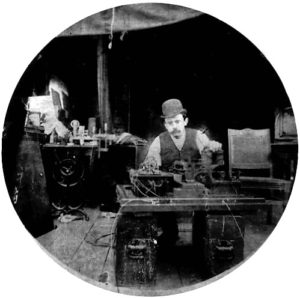Good morning, Whitewater.
Our month ends on a day of partly cloudy skies with a high of seventy-eight. Sunrise is 6:19 AM and sunset 7:29 PM, for 13h 09m 29s of daytime. We’ve a new moon, with just .9% of its visible disk illuminated.
Marquette Law publishes a new Wisconsin poll this afternoon. I’ll have highlights when they’re available.
On this day in 1897, Edison patents the kinetograph:
Charles Kayser of the Edison lab seated behind the Kinetograph. Portability was not among the camera’s virtues. Via Wikipedia.
Thomas Edison receives a patent for his movie camera, the Kinetograph. Edison had developed the camera and its viewer in the early 1890s and staged several demonstrations.
The camera was based on photographic principles discovered by still-photograph pioneers Joseph Nicephone Niepce and Louis Daguerre of France. In 1877, inventor Edward Muybridge developed a primitive form of motion pictures when Leland Stanford, governor of California, invited him to develop photo studies of animals in motion. Muybridge developed an ingenious system for photographing sequential motion, setting up 24 cameras attached to trip wires stretched across a racetrack. As the horse tripped each wire, the shutters snapped. The resulting series of photos could be projected as something resembling a motion picture. This breakthrough in the early 1870s inspired another student of animal motion, Etienne Jules Marey of France, to develop in 1882 a rotating camera rather like a rifle, where different pictures were taken in a rapid sequence by a rotating cartridge.
Unlike these earlier cameras, Edison’s Kinetoscope and Kinetograph used celluloid film, invented by George Eastman in 1889. In February 1893, Edison built a small movie studio that could be rotated to capture the best available sunlight. He showed the first demonstration of his films—featuring three of his workers pretending to be blacksmiths—in May 1893.
It’s a seahorse puzzle from JigZone for Wednesday:

